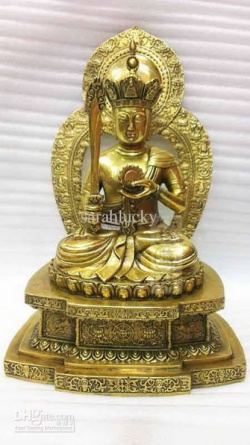Difference between revisions of "Akashagarbha"
| Line 4: | Line 4: | ||
[[虚空蔵菩薩]] (Skt; Jpn [[Kokuzo-bosatsu]]) | [[虚空蔵菩薩]] (Skt; Jpn [[Kokuzo-bosatsu]]) | ||
| − | The [[bodhisattva | + | The [[bodhisattva Space Treasury]]. A [[bodhisattva]] whose [[wisdom]] and good [[fortune]] are said to be as vast and [[boundless]] as the [[universe]]. |
[[Ākāśagarbha]] [[Bodhisattva]] ([[Sanskrit]]: [[आकाशगर्भ बोधिसत्त्व]]; [[traditional]] {{Wiki|Chinese}}: [[虛空藏菩薩]]; pinyin: [[Xūkōngzàng Púsà]]; [[Korean]]: [[허공장보살]]; {{Wiki|Japanese}}: [[Kokūzō Bosatsu]]; [[Tibetan]]: [[Namkhai Nyingpo]]) is a [[Mahāyāna]] [[bodhisattva]] who is associated with the [[great element]] ([[mahābhūta]]) of [[space]] ([[ākāśa]]). | [[Ākāśagarbha]] [[Bodhisattva]] ([[Sanskrit]]: [[आकाशगर्भ बोधिसत्त्व]]; [[traditional]] {{Wiki|Chinese}}: [[虛空藏菩薩]]; pinyin: [[Xūkōngzàng Púsà]]; [[Korean]]: [[허공장보살]]; {{Wiki|Japanese}}: [[Kokūzō Bosatsu]]; [[Tibetan]]: [[Namkhai Nyingpo]]) is a [[Mahāyāna]] [[bodhisattva]] who is associated with the [[great element]] ([[mahābhūta]]) of [[space]] ([[ākāśa]]). | ||
| Line 20: | Line 20: | ||
The [[mantra]] of [[Ākāśagarbha]] is popularly used by [[Shingon]] [[Buddhists]], {{Wiki|Chinese}} [[Buddhists]] following [[esoteric]] practices, and by artists. It is believed to give rise to [[wisdom]] and creativity, and dispel [[ignorance]]. | The [[mantra]] of [[Ākāśagarbha]] is popularly used by [[Shingon]] [[Buddhists]], {{Wiki|Chinese}} [[Buddhists]] following [[esoteric]] practices, and by artists. It is believed to give rise to [[wisdom]] and creativity, and dispel [[ignorance]]. | ||
| − | {{Wiki|Chinese}}: | + | {{Wiki|Chinese}}: Namo Xukongzang Pusa |
| − | [[Korean]]: | + | [[Korean]]: Namu Heogongjang Bosal |
| − | [[Vietnamese]]: | + | [[Vietnamese]]: Nam Mo Hu Khong Tang Bo Tat |
Translation: Homage to [[Ākāśagarbha Bodhisattva]] | Translation: Homage to [[Ākāśagarbha Bodhisattva]] | ||
Another [[mantra]] also [[exists]] for [[Ākāśagarbha]] [[Bodhisattva]]: | Another [[mantra]] also [[exists]] for [[Ākāśagarbha]] [[Bodhisattva]]: | ||
| − | [[Sanskrit]]: | + | [[Sanskrit]]: namo ākāśagarbhāya oṃ ārya kamari mauli svāhā |
| − | {{Wiki|Chinese}}: | + | {{Wiki|Chinese}}: 南牟,阿迦捨,揭婆耶,唵,阿唎,迦麼唎,慕唎,莎訶! |
{{Wiki|Japanese}} pronunciation: nōbō akyasha kyarabaya on arikya mari bori sowaka | {{Wiki|Japanese}} pronunciation: nōbō akyasha kyarabaya on arikya mari bori sowaka | ||
Translation: In the [[name]] of [[ākāśa-garbhāya]] Om Flower-Garland Lotus-Crown may it be accomplished | Translation: In the [[name]] of [[ākāśa-garbhāya]] Om Flower-Garland Lotus-Crown may it be accomplished | ||
Revision as of 15:18, 4 January 2014
Akashagarbha
虚空蔵菩薩 (Skt; Jpn Kokuzo-bosatsu)
The bodhisattva Space Treasury. A bodhisattva whose wisdom and good fortune are said to be as vast and boundless as the universe.
Ākāśagarbha Bodhisattva (Sanskrit: आकाशगर्भ बोधिसत्त्व; traditional Chinese: 虛空藏菩薩; pinyin: Xūkōngzàng Púsà; Korean: 허공장보살; Japanese: Kokūzō Bosatsu; Tibetan: Namkhai Nyingpo) is a Mahāyāna bodhisattva who is associated with the great element (mahābhūta) of space (ākāśa).
Ākāśagarbha is regarded as one of the eight great bodhisattvas. His name can be translated as "boundless space treasury" or "void store" as his wisdom is said to be boundless as space itself. He is sometimes known as the twin brother of the "earth store" bodhisattva Kṣitigarbha, and is even briefly mentioned in the Kṣitigarbha Bodhisattva Pūrvapraṇidhāna Sūtra.
Kūkai, the founder of Shingon Buddhism, met a famous monk who is said to have repeatedly chanted a mantra of Ākāśagarbha as a young Buddhist acolyte. Kūkai took a tutorial with him on Kokuzou-Gumonji (a secret doctorine method, 虚空蔵求聞持法). As he chanted the mantra, he experienced a vision whereby Ākāśagarbha told him to go to China to seek understanding of the Mahāvairocana Abhisaṃbodhi Sūtra. Later he would go to China to learn Esoteric Buddhism from Huiguo, and then go on to found the Shingon school in Japan.
Sūtras
Two Mahāyāna sūtras are known to survive in which Ākāśagarbha Bodhisattva is a central figure:
《虛空藏菩薩經》 (Ākāśagarbha Bodhisattva Sūtra)
《虛空藏菩薩神咒經》 (Ākāśagarbha BodhisattvaDhāraṇī Sūtra)
Mantras
The mantra of Ākāśagarbha is popularly used by Shingon Buddhists, Chinese Buddhists following esoteric practices, and by artists. It is believed to give rise to wisdom and creativity, and dispel ignorance.
Chinese: Namo Xukongzang Pusa
Korean: Namu Heogongjang Bosal
Vietnamese: Nam Mo Hu Khong Tang Bo Tat
Translation: Homage to Ākāśagarbha Bodhisattva
Another mantra also exists for Ākāśagarbha Bodhisattva:
Sanskrit: namo ākāśagarbhāya oṃ ārya kamari mauli svāhā
Chinese: 南牟,阿迦捨,揭婆耶,唵,阿唎,迦麼唎,慕唎,莎訶!
Japanese pronunciation: nōbō akyasha kyarabaya on arikya mari bori sowaka
Translation: In the name of ākāśa-garbhāya Om Flower-Garland Lotus-Crown may it be accomplished
Tantric rituals surrounding Ākāśagarbha are only given to students initiated in esoteric Buddhist lineages by an approved teacher. Currently the Chinese (Hanmi) Esoteric School is teaching his tantric ritual to the general public.
See Space Treasury.
